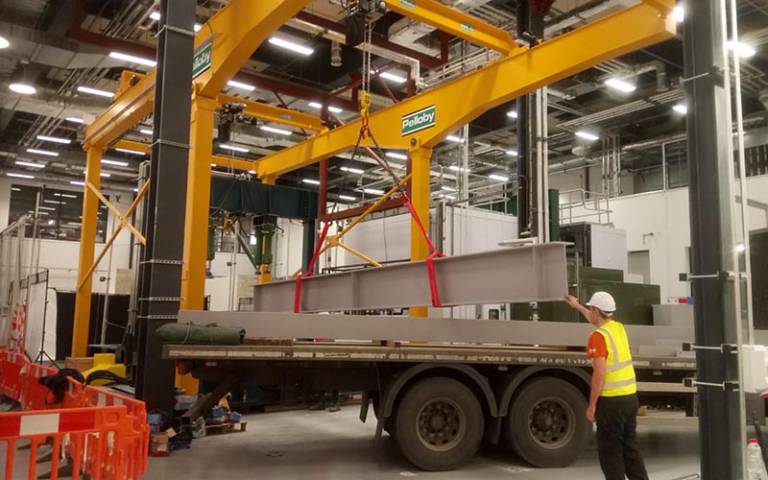Design of road bridges using advanced materials to improve based on UCL project
Results from a field project focused on the impact of heavy vehicles on an Oxfordshire bridge have fed into Highways England’s updating of bridge design guidelines.

18 February 2021
FRP bridges show strong potential
Glass and carbon fibre reinforced polymers (G/CFRPs) are materials which are low-cost and rustproof, with high stiffness and strength. They've transformed the wind turbine, passenger aircraft and high-performance yacht industries.
FRPs also show huge potential to revolutionise road bridge technology. However, to ensure that such bridges can become mainstream, the approaches to their structural design must evolve.
One key design consideration focuses on wheel load fatigue. This refers to the cumulative effects of passing lorry wheels on the structural integrity of the bridge deck over time.
Dr Wendel Sebastian from UCL’s Department of Civil, Environmental and Geomatic Engineering (CEGE) says that: “FRP bridges are light, stiff, strong, modular and durable options for road applications. If the high durability requirement is to become manifest, then FRP bridge decks must have adequate wheel load fatigue resistance.”
Bridge repair provides chance to install sensors
An opportunity arose for Wendel to lead a study into wheel load effects during repair of the West Mill GFRP bridge in Oxfordshire. Constructed in 2002, this was the first all-FRP deck-and-beam bridge in western Europe.
High-speed sensors were installed on the bridge to measure both the wheel loads and the deck’s response to those loads. In parallel, a sophisticated numerical model of the bridge was developed to further elucidate the deck’s mechanics. It was verified by sensor data logged during lorry tests conducted on the bridge at various stages of repair.
Since the bridge was returned to service, the sensors (which continue to perform well) have gathered more data on the effects of fast-moving lorries on the deck. Hence the repaired West Mill bridge is also a unique testbed for underpinning innovation in FRP bridges.
Wendel received funding for the project from the Engineering and Physical Sciences Research Council’s (EPSRC) Impact Acceleration Account (IAA), distributed by UCL Innovation & Enterprise. Highways England, Oxfordshire County Council and Skanska also supported the project.
“The EPSRC IAA funding has enabled a step change to our FRP bridge assessment capability,” said Wendel.
FRP bridge advice issued in 2020
This project’s outputs have been used to update the FRP bridge design guidance document, CD 368, released by Highways England in 2020. Consequently, such decks will be far less prone to progressive damage, with considerable savings on inspection and maintenance bills.
“CD 368 will help keep the UK at the leading edge of FRP bridge design and technology worldwide,” said Wendel. “This will in turn translate into better performing road networks, and so into enhanced economic prosperity and better connectivity between communities.”
Wendel is also feeding the key outputs from this project into a technical specification which is under development by a UK and pan-European committee. He recently hosted a meeting of this committee at UCL.
A scientific paper on this work has been published in the Engineering Structures journal.
Plans to further develop research
The installed sensors continue to perform well, so structural health monitoring of the West Mill bridge will continue.
Lessons learned from the logged data will inform tests to be conducted at the UCL CEGE Department’s state-of-the-art structural engineering laboratory, to further improve FRP bridge technology.
Wendel has also been invited by Highways Agencies in Europe to implement similar monitoring schemes on their FRP road bridges.
Links
Find out more about:
- funding for knowledge exchange projects
- innovation and enterprise support for UCL staff
- support for organisations to partner with UCL
- UCL Department of Civil, Environmental and Geomatic Engineering
- Highways England design document CD 368
- Engineering Structures paper
Photo of UCL CEGE’s new structural engineering laboratory © Dr Wendel Sebastian
 Close
Close

